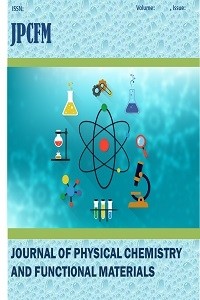The Relationship between Kidney Stones and Dietary Habits Using XRF Technique
The Relationship between Kidney Stones and Dietary Habits Using XRF Technique
XRF kidney stone, core elements, dietary,
___
- 1. K. Malhotra, Medical aspects of renal stones. Journal Indian Academy of Clinical Medicine, 2008. 9(4): p. 282.
- 2. I. Sorokin, et al., Epidemiology of stone disease across the world. World Journal of Urology, 2017. 35(9): p. 1301-1320.
- 3. O.R. Karabacak, et al., Stone compositions in Turkey: an analysis according to gender and region. Urology, 2013. 82(3): p. 532-538.
- 4. A. Srivastava, Determination of minor and trace elements concentration in kidney stones using elemental analysis techniques. 2014.
- 5. V.K. Sigurjonsdottir, et al., Impact of nephrolithiasis on kidney function. BMC nephrology, 2015. 16(1): p. 149.
- 6. I.A. Abboud, Concentration effect of trace metals in Jordanian patients of urinary calculi. Environmental Geochemistry and Health, 2008. 30(1): p. 11-20.
- 7. B. Keshavarzi, et al., Trace elements in urinary stones: a preliminary investigation in Fars province, Iran. Environmental geochemistry and health, 2015. 37(2): p. 377-389.
- 8. M.L. Giannossi, V. Summa, and G. Mongelli, Trace element investigations in urinary stones: a preliminary pilot case in Basilicata (Southern Italy). Journal of Trace Elements in Medicine and Biology, 2013. 27(2): p. 91-97.
- 9. S. Chandan, et al., Variability of protein content and its role in kidney stone formation. 2011.
- 10. R.A. Shaker, M. Al-Gazally, and E.H. Al-Jaff, The measurement of intact parathyroid hormone and serum electrolytes and their relation with renal stones in Hilla city. Med J Babylon, 2012. 9: p. 159-165.
- 11. A.H. Afaj and M.A. Sultan, Mineralogical composition of the urinary stones from different provinces in Iraq. TheScientificWorldJOURNAL, 2005. 5.
- 12. M. Jayachandran, et al., Extracellular vesicles in urine of women with but not without kidney stones manifest patterns similar to men: a case control study. Biology of sex differences, 2015. 6(1): p. 2.
- 13. D.A. Schulsinger, Kidney Stone Disease. Vol. 435. 2015: Springer.
- 14. D.A. Schulsinger, The stone belt, in Kidney Stone Disease. 2015, Springer. p. 55-67.
- 15. A. D’Amato, Y. Sheynkin, and D.A. Schulsinger, The Rock of Ages: Stones Have Stood the Test of Time!, in Kidney Stone Disease. 2015, Springer. p. 27-30.
- 16. A.M. Lum, et al., Retroviral activation of the mir-106a microRNA cistron in T lymphoma. Retrovirology, 2007. 4(1): p. 5.
- 17. M. Daudon and D.C. Bazin, Application of physical methods to kidney stones and Randall’s plaque characterization, in Urolithiasis. 2012, Springer. p. 683-707.
- 18. B.G. Oztoprak, et al., Analysis and classification of heterogeneous kidney stones using laser-induced breakdown spectroscopy (LIBS). Applied spectroscopy, 2012. 66(11): p. 1353-1361.
- 19. C.Y. Pak, Kidney stones. The lancet, 1998. 351(9118): p. 1797-1801.
- 20. W.A. Hunt, Kidney Disease: A Guide for Living. 2011: JHU Press.
- 21. E.N. Taylor and G.C. Curhan, Demographic, dietary, and urinary factors and 24-h urinary calcium excretion. Clinical Journal of the American Society of Nephrology, 2009. 4(12): p. 1980-1987.
- 22. P.M. Ferraro, A. D'Addessi, and G. Gambaro, When to suspect a genetic disorder in a patient with renal stones, and why. Nephrology Dialysis Transplantation, 2013. 28(4): p. 811-820.
- 23. G.C. Curhan, et al., Body size and risk of kidney stones. Journal of the American Society of Nephrology, 1998. 9(9): p. 1645-1652.
- 24. D.W. Killilea, et al., Elemental content of calcium oxalate stones from a canine model of urinary stone disease. PloS one, 2015. 10(6): p. e0128374.
- ISSN: 2651-3080
- Yayın Aralığı: Yılda 2 Sayı
- Başlangıç: 2018
- Yayıncı: Niyazi BULUT
Production, Structural and Morphological Characterization of Feather-Reinforced Epoxy Composites
Tankut ATEŞ, Niyazi BULUT, Omer KAYGILI, Serhat KESER
Carbon-Tunable p-type ZnO Nanoparticles for Enhanced Photocatalytic Removal of Eriochrome Black T
Density Function Theory Study of the Physicochemical Characteristics of 2-nitrophenol
Othman HAMAD, Rebaz OBAID KAREEM, Omer KAYGILI
Quantum Chemical Study of Some Basic Organic Compounds as the Corrosion Inhibitors
Lana AHMED, Niyazi BULUT, Omer KAYGILI, Rebaz OMER
M.mürşit TEMÜZ, Pelin KOPARIR, Mehmet YILDIRIM
Exploring The Synthesis of 1,2,4-Triazole Derivatives: A Comprehensive Review
Rebaz OMER, Rzgar Farooq RASHİD, Khdir OTHMAN
The Relationship between Kidney Stones and Dietary Habits Using XRF Technique
Lana AHMED, Assist.prof.dr. Faten Adel CHAQMAQCHEE, Rebaz OMER
